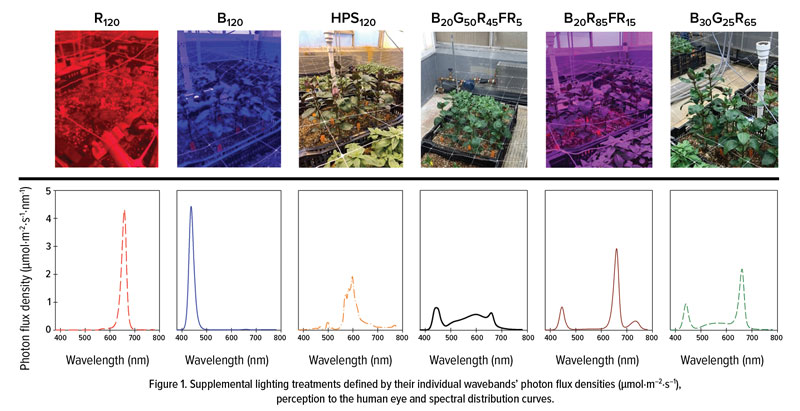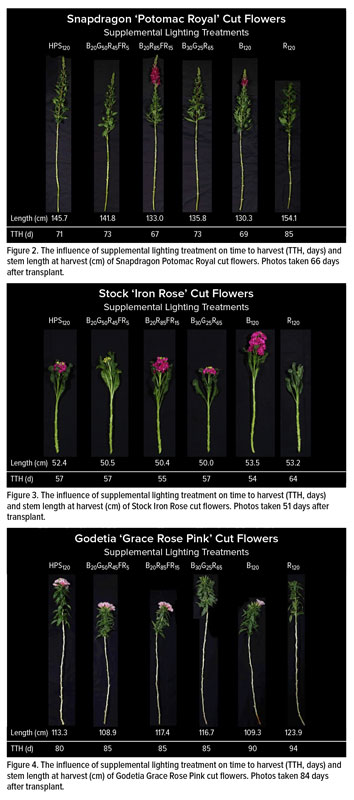1/1/2024
Cut Flowers & Lighting
Caleb Spall & Roberto Lopez
In recent years, burgeoning demand for fresh, unique and locally grown specialty cut flowers has encouraged year-round production across the United States. While some regions of the U.S. permit outdoor production year-round, northern regions experience low temperatures, daylengths and light intensities during the winter and early spring, inhibiting outdoor production. To combat this, growers in these regions can utilize greenhouses to provide ideal environmental conditions for high-quality specialty cut flower production, allowing for year-round sales, premium prices and consumer satisfaction.
Of the environmental parameters that can be controlled within greenhouses, light duration (photoperiod) and light intensity (with supplemental lighting) are of critical importance for regulating flowering responses and overall finished cut flower quality. This is especially true in the northern U.S. during the winter and early spring when the daylength is short, limiting what varieties of cut flowers can be grown without daylength regulation.
For instance, popular cuts that require daylengths >12 hours (long-day plants; LDPs) for flower initiation, including flossflower (ageratum), snapdragon (antirrhinum), bell flower (campanula), Sweet William (dianthus) and stock (matthiola) may not flower as quickly, or flower at all, without daylength extension. Moreover, cut flowers grown under light-limiting conditions may produce fewer and thinner harvestable stems compared to cut flowers grown with supplemental lighting providing 90 to 120 μmol·m–2·s–1 of light.
Additionally, the spectrum of light emitted from supplemental lighting sources can vary between fixtures and can have profound impacts on cut flower development time and finished quality when the solar light intensity is low. Therefore, we sought to quantify the influence of light quality from supplemental lighting on the growth and developmental responses of the obligate LDP plant godetia (Clarkia amoena), and facultative LDPs snapdragon (Antirrhinum majus) and stock (Matthiola incana) cut flowers.
The experiment
Bulb crates containing Godetia Grace Rose Pink, Snapdragon Potomac Royal and Stock Iron Rose seedlings were placed in one of six separate greenhouses, each with supplemental lighting fixtures providing different light spectra. All the fixtures operated at an intensity of 120 μmol·m−2·s−1 for 12 hours per day for four weeks, after which flowering was induced by extending the daylength to 16 hours for the remainder of the crop cycle.
The supplemental lighting treatments, defined by their 100-nm wavebands of blue (B), green (G), red (R) and far-red (FR) radiation (photon flux density in μmol·m–2·s–1) were B7G60R44FR9, B20G50R45FR5, B30G25R65, B20R85FR15, R120 or B120. The first treatment was created with high-pressure sodium (HPS) fixtures, whereas the others were created with high-intensity LED fixtures (Figure 1). The air average daily temperature set points in each greenhouse compartment was 60F (16C) [12 hours day/12 hours night 65/55F (18.5/13C)].
Generally, time to visible bud, open flower and harvest occurred faster under supplemental lighting from HPS lamps providing B7G60R44FR9, and LEDs providing B20R85FR15 and B120, while development was delayed under LED supplemental lighting providing R120 (Figures 2, 3 and 4).
For instance, time to harvest of godetia, snapdragon and stock was nine, 18 and nine days slower, respectively, when grown under supplemental lighting providing R120 compared to B20R85FR15. Flowering was slightly delayed for plants grown under either broad-spectrum LEDs (white light) providing B20G50R45FR5 or B30G25R65, although not as drastically as supplemental lighting providing R120 (Figures 2, 3 and 4).
Additionally, stem lengths were up to 6%, 16% and 6% longer, respectively, for godetia, snapdragon and stock grown under supplemental lighting providing R120 compared to supplemental lighting providing B20R85FR15. The influence of supplemental lighting on time to harvest and stem length at harvest of Snapdragon Potomac Royal is depicted in Figure 2. Snapdragon grown under supplemental lighting providing R120 had up to 23% more branches at harvest than those grown under supplemental lighting providing B20R85FR15. Stem caliper was similar for godetia and stock regardless of treatment, though stock stem caliper was 14% thinner when grown under supplemental lighting providing B120 compared to the other treatments.
Time to first visible bud, open flower and harvest, finished stem quality, ability to visually access the crop and fixture photon efficacy must be considered when selecting the spectrum of supplemental lighting fixture for one’s growing operation. Based on our findings, we recommend growing cut flowers under fixtures emitting a spectrum similar to B20R85FR15, or broad-spectrum LED fixtures that emit light that appears white to the human eye, to elicit desirable crop responses while allowing for sufficient human visibility. While high-quality cut flowers were produced under HPS supplemental lighting, LED fixtures provide increased energy efficacy, cooler operating temperatures and reduced operating costs. GT
Acknowledgements: Association of Specialty Cut flower Growers (ASCFG), Sakata Seed America and PanAmerican Seed for funding, as well as Raker-Roberta’s Young Plants for sowing seeds; Hydrofarm for supportive netting; J.R. Peters for fertilizer; Fluence Bioengineering, Heliospectra, P.L. Light Systems and Philips LED Lighting for LED fixtures; and Nate DuRussel, John Gove and Ian Holcomb for greenhouse assistance.
Caleb Spall is a former M.S. student and Roberto Lopez is an Associate Professor and Controlled Environment/Floriculture Extension Specialist in the Department of Horticulture at Michigan State University.

